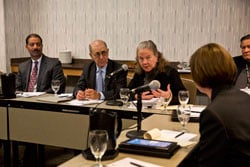ABA looks to aid underserved clients and underemployed lawyers

Photo of task force co-chairs Eric Washington, Allan Tanenbaum and Patricia White by Wayne Slezak.
When James Silkenat became president of the American Bar Association last August, he identified as one of his top priorities the creation of a job corps for new lawyers. To that end, he announced the formation of the Legal Access Job Corps to tackle the lack of adequate legal representation for disadvantaged communities and the glut of unemployed and underemployed lawyers.
Silkenat and the ABA Legal Access Job Corps Task Force received a progress report during the ABA Midyear Meeting from several state and local organizations that have sought to address this imbalance. The task force vowed to spend the second half of 2014 examining ways the ABA can play a greater role in financing and supporting these and other programs. The task force also unveiled a video that it hopes will better drive home the depths of the problems facing underrepresented individuals and underemployed lawyers.
“We don’t do a good enough job educating the public,” said Chief Judge Eric Washington of the District of Columbia Court of Appeals, who serves as co-chair of the task force alongside Allan Tanenbaum, managing partner of Equicorp Partners in Atlanta, and Patricia White, dean of the University of Miami School of Law. “Hopefully, this video will elevate this important issue.”
GAPS TO CLOSE
Organizations trying to alleviate the problems caused by lack of access to justice and inability to serve have approached the issues in different ways.
The Chicago Bar Foundation’s Justice Entrepreneurs Project focuses on low- and moderate-income people who make too much money to qualify for free legal aid and not enough to afford traditional law firm rates. The program, started last June, also serves as an incubator for recent law school graduates who wish to form their own socially conscious law firms.
Attorneys in the project receive a $1,000 monthly stipend and provide free services. Lawyers also will be expected to generate business by finding paying clients. The project, set to grow to 30 lawyers by next spring, is committed to fixed-fee arrangements and using technology to better serve clients.
In South Dakota and Maine, state bar associations are trying to solve a geographic and social problem by placing young attorneys in rural areas. In both states, the vast majority of lawyers are concentrated in metropolitan areas, leaving rural residents underrepresented. The State Bar of South Dakota’s Project Rural Practice pairs young lawyers with established attorneys in rural areas in the hopes that the young attorneys might eventually succeed their older mentors. Maine—which is the oldest state in the country, in terms of median age—has a similar program.
This article originally appeared in the April 2014 issue of the ABA Journal with this headline: “Aiding Underserved Clients, Underemployed Lawyers.”
Correction
Print and initial online versions of “Aiding Underserved Clients, Underemployed Lawyers,” April, should have identified Eric Washington as chief judge of the District of Columbia Court of Appeals.The ABA Journal regrets the error.

.jpg)

